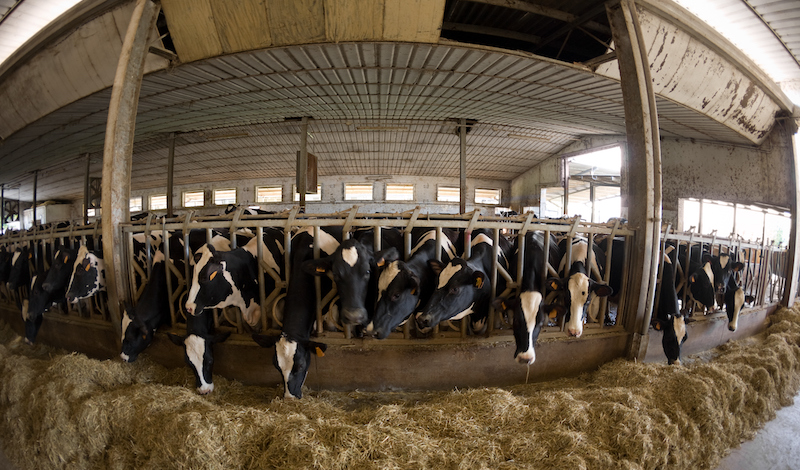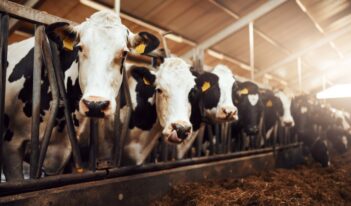
Scholars discuss public health harms from the underregulation of factory farms and propose potential solutions.
When consumers think of animal byproducts, milk and eggs may come to mind. But some scholars are concerned with a lesser-known kind of meat byproduct: contamination. Public health advocates argue that the mass production of meat is also mass producing pollutants, contaminants, and bacteria that are making Americans sick.
U.S. demand for meat has fed the rise of a powerful industrial livestock sector, which relies on concentrated animal farming operations (CAFOs), or “factory farms,” to produce cheap meat en masse. Although factory farming is touted as a cost-effective way to meet demand, critics suggest that the public ultimately pays the price with their health.
Public health and environmental advocacy groups recently petitioned for increased regulation of CAFOs. They claim that overcrowded and under-sanitized factory farms facilitate the spread of illness and disease to consumers and localities surrounding CAFOs. CAFO waste management practices, which some advocates insist are dangerously underregulated, can lead to the runoff of hormones, antibiotics, chemicals, and other fecal bacteria into local water sources, soil, and air. Studies suggest that communities within close proximity to CAFOs suffer from higher rates of deadly diseases as a result.
The United States Department of Agriculture (USDA) and the Environmental Protection Agency (EPA) regulate CAFOs at the federal level. USDA regulates the production of meat and poultry products through the The Food Safety Inspection Service, which ensures products are safe for consumption and that sanitary conditions are maintained within facilities. EPA determines which livestock facilities qualify as CAFOs and regulates their sanitation and waste management in accordance with the Clean Water Act (CWA).
Some industry experts argue that EPA has not been fulfilling its duties, as CAFO contamination often evades regulation through exceptions and under-enforcement. In 2008, the U.S. Government Accountability Office determined that EPA officials did not know how many CAFOs existed within the United States, and that the agency was failing to regulate them properly.
Some advocates speculate that the lack of CAFO regulation may be due to pressure from the meat industry. Meat industry lobbyists and interest groups have often argued against environmental regulations.
In this week’s Saturday Seminar, scholars discuss the health impacts of CAFOs and offer solutions to improve factory farming regulation.
- In a report published by the Natural Resources Defense Council (NRDC), Lee Miller of Duke Law School and Gregory Muren of EarthJustice argue that CAFOs are active health hazards that stand unregulated. Reporting the findings of a decade-long NRDC investigation, Miller and Muren suggest that CAFOs are polluting U.S. water, air, and soil, exposing citizens to disease-causing chemicals and high concentrations of antibiotics. They claim that the investigation uncovered an absence of EPA enforcement and an alarming lack of critical data on how many CAFOs exist, their operations, and their waste management practices. Miller and Muren argue that EPA is captive to the influence of the corporate livestock industry, but they find hope in states moving to improve regulations and transparency.
- Land use controls may provide innovative ways to alleviate the harms caused by CAFOs, claims Nicole Gilliland in a paper published in the Southern California Interdisciplinary Law Journal. Gilliland finds that underregulated CAFOs are responsible for a myriad of health harms, such as groundwater pollution, disease spread, and air contamination. Although these CAFOs produce approximately 99 percent of U.S. meat, she argues that they evade regulation by federal agencies through statutory exemptions and underenforcement, likely due to the influence of U.S. meat and dairy lobbies. Gilliland suggests imposing several land use controls to mitigate CAFO harms, including impact and license fees, special assessments, excise business taxes, industrial zoning regulations, conditional land use, performance zoning, public nuisance laws, and environmental codes.
- In a recent article issued by Environmental and Resource Economics, Romain Espinosa of the Université de Rennes, Damian Tago of the Food and Agricultural Organization of the United Nations, and Nicholas Treich of the Toulouse School of Economics explore the role of intensive animal farming in the spread of infectious diseases. CAFO practices allow for the emergence and amplification of pathogenic viruses, they explain, as large numbers of immunodeficient animals are crowded into enclosed spaces. Espinosa, Tago, and Treich argue that animal crowding allows pathogens to spread quickly and mutate, greatly increasing the likelihood of a human-transmissible mutation. To combat this infection spread, they find that CAFOs dose animals with preventative antimicrobials, but this results in immune system suppression and antimicrobial resistant pathogen strains. They claim that the resulting risk of human infection exists not only for consumers, but for CAFO workers and neighbors, who are exposed to waste and airborne pathogens. Although the current regulatory framework focuses on supply side monitoring and prevention, the authors suggest redirecting focus to the demand side and reducing meat consumption to combat the spread of infectious disease.
- To promote human, animal, and environmental welfare, developing nations should reject large-scale -factory farming, argues Courtney G. Lee of the University of the Pacific McGeorge School of Law in an article published in the UC Davis Law Review. In addition to factory farming’s negative impact on the public and economic health of general consumers, the industry also exploits and endangers workers and surrounding communities, she contends. Lee posits that developing nations can avoid these pitfalls encountered by industrialized nations such as the United States and U.A.E. by reducing demand and promoting sustainable agriculture.
- In an article published in New Solutions: A Journal of Environmental and Occupational Health Policy, Caitlin A. Ceryes and Christopher D. Heaney of the Johns Hopkins Bloomberg School of Public Health discuss “ag-gag” laws and the harmful ways in which they impact research and reporting on industrial food animal production (IFAP), which includes CAFOs. Ag-gag laws, they explain, restrict public access to information about agricultural facilities by prohibiting videos or photographs of such facilities without consent, as well as fraudulent job applicants to these facilities for the purpose of collecting data. Furthermore, Ceryes and Heaney discuss the changes in food animal production–such as poor treatment of animals and workers–that have resulted in public health concerns stemming from IFAP facilities. Ceryes and Heaney contend that ag-gag laws are concerning because they limit researchers’ abilities to collect data and investigate IFAP worker health and health concerns in surrounding communities. They suggest that researchers could collaborate with advocacy groups to study how such laws affect the reporting and regulation of IFAP harms.
- In an article published in The Milbank Quarterly, Parke Wilde of the Tufts University Friedman School of Nutrition Science and Policy and several coauthors find that processed meat and red meat consumption lead to an increased risk of developing cancer. In light of this evidence, they propose four types of regulatory solutions to reduce processed meat consumption, which include “(1) nutrition standards, (2) taxation, (3) public service announcements, and (4) warning labels.” They explore the legal feasibility of each proposed policy response, concluding that only the fourth response, warning labels, could face legal obstacles, due to anticipated First Amendment objections by manufacturers. Despite these solutions’ legal feasibility, Wilde and his coauthors argue that the main hurdle to policy change will likely be overcoming the meat industry’s political power.



